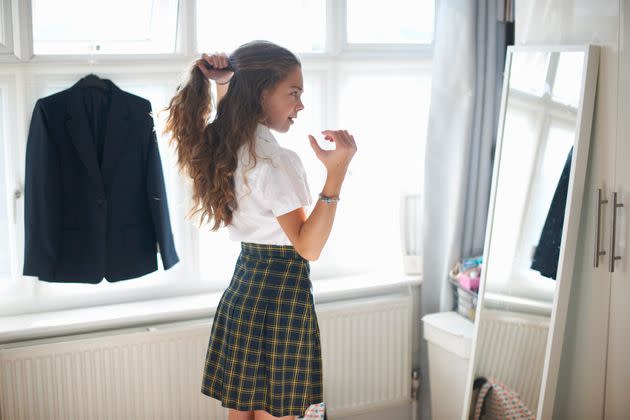Having 'The Talk' About Skimpy Clothing? Avoid These Mistakes.

Teens and their parents will inevitably disagree about many things, from curfew to allowance. Another common point of conflict is clothing, especially when a teen’s aesthetic is more revealing than parents would like.
Some parents would like their teens to dress more modestly. Others don’t mind bare skin but are concerned about their child’s well-being and how others might perceive them.
“It’s still a sad reality that what people wear can bring bad attention,” said Rudy Hernandez, a mental health therapist at Kaiser Permanente in California. “As a parent, we have an instinct to protect them from reputational, verbal and possible emotional abuse” they may encounter if they wear barely there clothing, he explained.
How can parents start a discussion?
Although it may be difficult for parents to keep their thoughts about skimpy clothing to themselves, Hernandez advises parents “to try their best to not criticize or judge the teen for their clothing choices.” Instead, he recommended that parents have “a broader conversation about style and what they’re hoping to get across.” Asking questions in a nonjudgmental way can open up a dialogue. Parents can ask,“Why do you want to wear that?” or “What sort of statement are you hoping to send with your clothing?” and pay close attention to the answers, Hernandez advised.
There may be many valid reasons teens want to wear skimpy clothing, explained Caroline Fenkel, a mental health expert and chief clinical officer at Charlie Health. “Clothing can be a form of self-expression for teens, allowing them to explore their identity and individuality,” she said. It can also give them a confidence boost if they “feel more confident and empowered when wearing clothing that they feel comfortable and attractive in,” she said. Additionally, certain clothing can lead to greater acceptance among peers. “Wearing clothing similar to that of peers can help teens feel like they belong and fit in with their social group,” Fenkel said.
After listening to your teen’s reasons for wanting to dress the way they do, parents can lead into a discussion of the dangers of wearing revealing clothing. Many parents are concerned that “certain clothing may attract unwanted attention or harassment, potentially compromising the teen’s safety,” Fenkel explained, and that certain clothing may lead to conflicts with others in the teen’s life who don’t approve of their clothing choices.
When parents let teens know that they are trying to protect them rather than control them, they may be more receptive to their parents’ message, Hernandez said. Parents should also be honest if they are not ready to see their children dress in such a grown-up manner, he said.
“We live in a very difficult and frightening time. Gone are the days of just ‘stranger danger.’ Kids are being stalked online, tracked in person, and manipulated on a global level,” Hernandez said. While clothing isn’t solely responsible, it can play a role in attracting unwanted attention. “I always suggest providing actual proof that there are inappropriate people out there watching and videotaping such outfits and trying to post them online,” he said.
This is important because “due to the adolescents’ development, they think it’s unlikely for bad things to happen to them,” explained Traci Williams, a child and family psychologist. Most teens experience a temporary stage of development called egocentrism, during which they “perceive themselves as invincible,” Williams said. According to Williams, this is “a normal part of adolescents’ cognitive development” that “results in teens inaccurately assessing possible risks.”
Don’t expect teens to agree
Parents shouldn’t expect teens to see their point of view immediately. “Teens push boundaries and push dialogue and want to prove a point,” Hernandez said.
Sharon Van Epps found this to be true when talking to her now-20-year-old daughter about revealing clothing when she was a teen. “She told me my reaction was ‘anti-feminist,’” Van Epps said. In response, Van Epps told her daughter that “we live in the unfair real world,” although she understood her daughter’s position.
According to therapist Carl Nassar, teens may also value independence over common sense. “Teens want a growing level of independence from parents, so they will, in general, ask for control over almost everything in their lives, including clothing choices, even when it’s to their own detriment,” he said.
What should parents avoid saying?
No matter what parents might be thinking, “telling your child they look ‘horrible’ or ‘trampy’ will cause hurt feelings, pain and trauma, which may cause them to criticize their own body,” Hernandez said. Telling teens they are “bad” because of what they want to wear can hurt their self-esteem, he added.
Additionally, parents should remain calm no matter how upset they feel about their teen’s choice of clothing. “We can usually get our point across if we display love and concern without shaming or yelling,” Hernandez advised.
Even if parents strongly oppose their teens’ clothing choices, Nassar advises against implementing an outright ban. “A hard ‘no’ often creates compliance at home and rebellion outside of the home,” he explained. To get around the rule, teens may sneak around and change into skimpy clothing once they are out of view. Instead, Nassar advises reaching a compromise.
“Examples of compromise might be the teen avoiding a specific sort of clothing that makes the parent most anxious” or limiting the number of days each week a teen wears revealing clothing, Nassar said. Hernandez also encourages parents to “discuss alternatives” with their teens such as wearing bike shorts under short skirts or a bandeau bra under a low-cut shirt.
Van Epps decided to compromise with her daughter by focusing “on dressing appropriately for the occasion.” For example, she encouraged her daughter to dress more conservatively for family events and at school but was more lenient at home and on weekends.

Sometimes rules are necessary
Clothing can give teens “the agency to share their body on their terms,” Williams said. Choosing what to wear is an important part of adolescent development and part of how “teens create their sense of identity,” she explained.
However, “if the clothing puts the teen at risk of harassment or other dangers, parental intervention may be necessary,” Fenkel said. Ultimately, “parents are responsible for setting boundaries and guidelines, including rules about clothing choices,” she said. However, any rules around clothing “should be reasonable and explained to the teen,” she said.
Teach teens to be cautious
If parents allow their teens to wear revealing clothing, they should teach their children to “be vigilant” of their surroundings so they are aware if someone is watching or filming them, Hernandez suggested.
Whether or not teens wear skimpy clothing, they will probably receive “unwanted attention” at some point, Williams said. “This can be a learning opportunity for teenagers, and parents can help facilitate by asking how they felt and creating solutions for handling similar future situations,” she said. Part of that discussion can be the role revealing clothing played in the incident.
What about school dress codes?
Even if parents are more permissive at home, school dress codes may dictate that kids cover up on school grounds.
Jillian Amodio, a licensed social worker and mother to a teenage daughter, buys her daughter crop tops with the understanding that she won’t wear them to school because they would violate her school’s dress code. She follows through with consequences for noncompliance. “I’ll be the first to admit that I’m not a fan of dress codes. But I am a fan of respect. And we don’t always have to agree with the rules of an establishment but we can still respect their existence,” Amodiosaid.
When Amodio’s daughter got in trouble for wearing crop tops to school in violation of both the school’s rules and her mother’s, Amodio confiscated the shirts for two weeks. She then gave her daughter the “opportunity to prove that she can handle making her own clothing choices responsibly.” Amodio explained that she ultimately returned the shirts to her daughter because “the clothing is not the problem, the choices are.”
Parents need to accept that having children means not agreeing with all of their decisions. “Ultimately, your teen will make decisions that you may not be aware of” or agree with, Williams said.
“Having to relinquish some of your control can be a difficult part of parenting,” she added.

